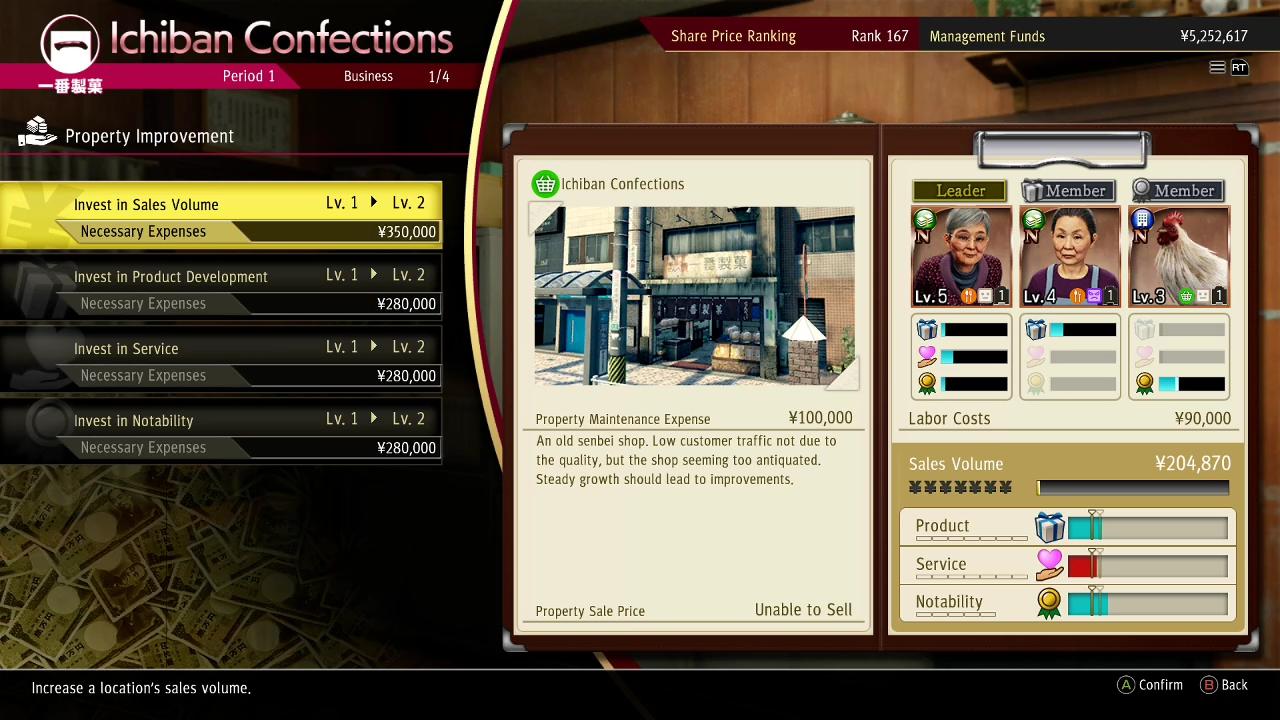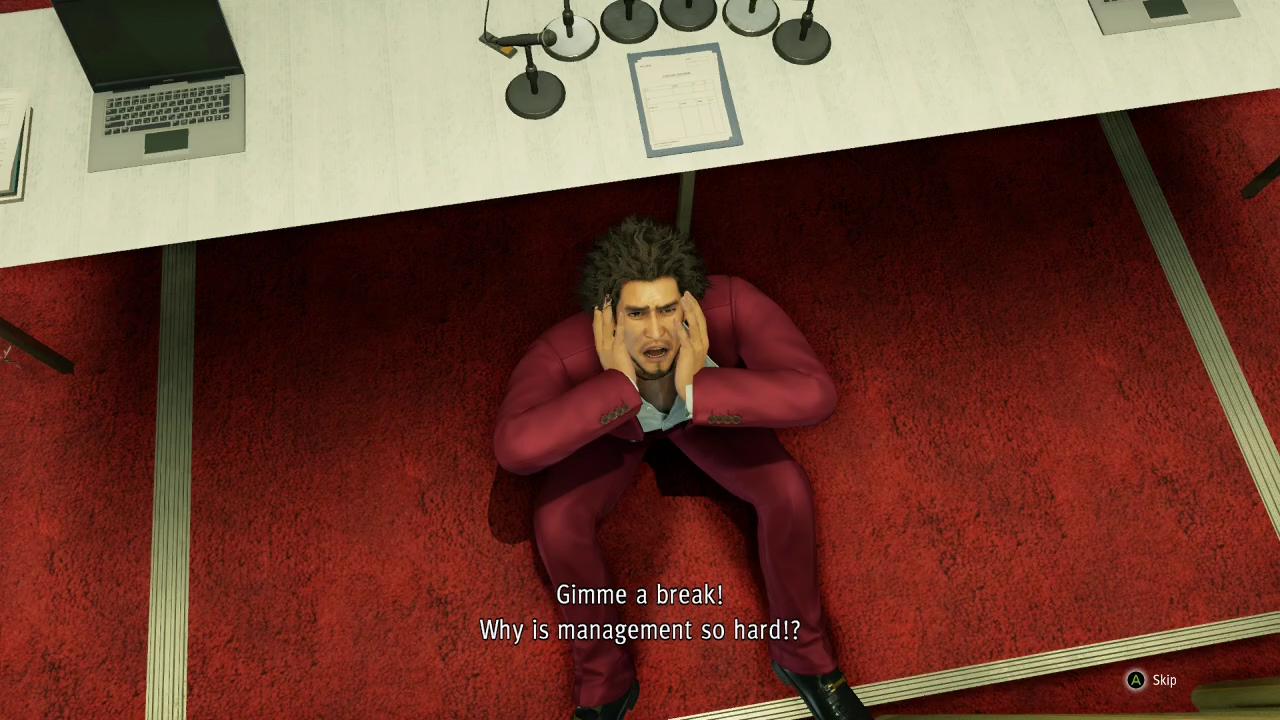How to master business management in Yakuza: Like a Dragon
Learn to assign employees and dominate shareholder meetings in this Yakuza: Like a Dragon management guide.

Are you trying to be the best at business management in Yakuza: Like A Dragon? Ichiban Confections starts at the bottom, and so must you. After you're first introduced to Ichiban Confections by Eri in chapter five (outside Otohime Land), the amount of menus and numbers can be daunting.
But with this Yakuza: Like a Dragon management guide to each part of running the company, you'll be a pro president in no time. Here I'll explain what the game doesn't, so you can learn to manage employees and battle shareholders until you're rolling in revenue.
How to make money from Yakuza: Like a Dragon management
Here's the bad news. If you've played Yakuza 0, you might be used to lining your character's pockets with the profits you make from your business. Alas, this isn't the Eighties anymore. You'll have to keep your personal and business finances separate. Ichiban can make money by running Ichiban Confections, but he won't be raking in millions of yen off the bat.
At certain points during Ichiban Confection's growth, you'll get an executive bonus for performing well during Shareholder Meetings. This starts at around 50,000 yen and grows into the hundred thousands as you climb the corporate rank pyramid. Grind away at those business periods if you want to line Ichiban's pockets quickly.
Hiring and assigning employees
When you first begin business management, check out the Employee Assignment section of your Properties menu. Each property has requirements for Product, Service, and Notability. Meanwhile, each employee you hire has a rating in these areas too, so you'll need to assign them to properties where they can be most useful.
You can choose from your pool of employees to assign a Leader, as well as up to two members per property. As a Leader, your employee will contribute all three of their skills to the property. Members will only contribute their skill value in one area, so pay attention to the slot you put them in and ensure you utilise their best skill.
If you want to turn a profit, you'll need to ensure your property meets the bars shown on screen for Product, Service, and Notability. If it doesn't, swap your employees around until all three bars at blue.
Keep up to date with the most important stories and the best deals, as picked by the PC Gamer team.
You can also hire new employees if there's a skill gap on a property you need to fill. Low-tier employees have marginal skills in all three areas, so they often aren't worth hiring. Keep an eye out for employees with either moderate skills across the board or who excel in one area.
Mind that you don't keep too many employees on your payroll. The Surplus Labor Costs under the Employees section of the main screen will show how much money you're paying in salaries to employees who are sitting on the bench.
Opening for business

This part of the management game is totally automated, so you don't have to do anything but watch Ichiban go. But wait! Before you open for business, check whether your employees are happy. If they have neutral or angry faces on their employee icons, they won't work as hard and you probably won't make the amount of money listed in your Expected Profit section. Early on in the management game, you could even fail to turn a profit at all. Yikes.
Ensuring your employees are happy will keep you in the green. Under the Employees menu, you can choose to spend money to boost the happiness of individual employees. You can also press the Auto Care button which will max out the happiness of all your employees. Watch their mood carefully because unhappy employees may quit.
Buying and improving properties

It's said you have to spend money to make money, and that's absolutely true here. After your first couple rounds of opening for business, you may want to invest in improving your properties.
Under the Property Improvement section of the Properties menu, you have four total ways to invest in each business. Investing in Sales Volume is like investing in the overall level of the property itself. A higher Sales Volume, naturally, means more profit.
However, when the sales potential of the property goes up, so do the bars for Product, Service, and Notability. If the bar is too high, your employees won't be able to fill the gap, so you'll need to invest in raising the Product Development, Service, and Notoriety levels of the property itself. Before improving a property, check how the bars for each skill will move up, so you know what else you might need to invest in before opening for business.
When considering which new properties to buy, pay attention to how much they can be upgraded. Some properties, like Ichiban Confections itself, can be upgraded multiple times. The yen symbols (¥) under the Sales Volume for the property tell you how many total times you can invest in it. The bars beneath the Product, Service, and Notability ratings tell you how many times each of those skills can be upgraded too. Some properties have smaller Sales Volume potential, meaning they won't be huge earners, but they might require only two one or two employees to turn a profit. Consider having a roster of both big swingers and more modest, yet steady, properties too. If a property isn't working out for you, sell it.
Shareholder meetings

Oh no, the dreaded Shareholder Meeting. Yakuza: Like A Dragon does a poor job explaining this fast-paced, real-time tactical battle. Don't worry though, we've got you covered.
As with opening for business, make sure your employees are happy before heading into a Shareholder Meeting (this is a good time to use that Auto Care function to max out the happiness of all employees). Happy employees are more powerful during the battle, while a happy overall workforce provides you a bonus before the meeting even begins.
Look at the Board Room section of your menu before heading into a Shareholder Meeting. Your company's net worth, employee happiness, and recent sales numbers all factor into the shareholder support for the company. Good or bad performance in each area will add or subtract from the base 50 percent Support you begin a Shareholder Meeting with. Starting out below 50 percent means a tougher fight, so investing in employee happiness at the last minute can help make up for your failures elsewhere. Before you head in, take a look at who you're bringing with you. Each employee has a colored symbol in the top left: blue, green, or red. Bring at least one of each, because the battle relies on a rock, paper, scissors system.
Alright, your employees are happy and you have a balanced team coming with you to attend the Shareholder Meeting. Time for battle! These move fast, so here's how to stay in control of the situation:

Calling on shareholders
Call on whoever's irritation meter is filling fastest. If they get fully irritated, they'll yell out a question anyway.
Shareholder questions
Ignore the words. Just note the color and then look at the red, green, and blue diagram in the left part of the screen. Quickly select an employee to rebut the question who has the colored symbol that is strongest against the color of the question being asked.
Red (people) beats green (money) which beats blue (facilities) which beats red.
What you're doing here is breaking the shareholder's guard (the three-shield symbols above their question). Choosing an employee whose skill is weak to the question will only break one shield. The same color will break two shields. The skill strongest against the question will break all three. If you don't manage to break their guard quickly enough, the shareholder will deal damage to the employee they're locked on to.
Employee attacks
After a shareholder's guard is broken, quickly call on your employees to deal damage directly to the shareholder's health. The number by each employee's name is their Command Cost. The bar at the bottom represents your Command Points. This will continually fill, replenishing faster the happier your employees are. If possible, call on your employees whose skill color is strong against that of the shareholder to deal more damage. A shareholder won't always ask a question of the same color as their own main skill, so pay attention to both.
Ichiban's apology skill
Don't forget about Ichiban's skill meter that fills during the battle. It can fill up to three times, represented by the blue, green, and yellow lights. A tier one apology does a little bit of damage to all shareholders. A tier two apology does more damage, recovers your employees a bit, and stuns the shareholders from asking questions briefly. A tier three apology works like tier two, but with additional Shareholder damage and healing to your team.

Lauren has been writing for PC Gamer since she went hunting for the cryptid Dark Souls fashion police in 2017. She accepted her role as Associate Editor in 2021, now serving as self-appointed chief cozy games and farmlife sim enjoyer. Her career originally began in game development and she remains fascinated by how games tick in the modding and speedrunning scenes. She likes long fantasy books, longer RPGs, can't stop playing co-op survival crafting games, and has spent a number of hours she refuses to count building houses in The Sims games for over 20 years.

